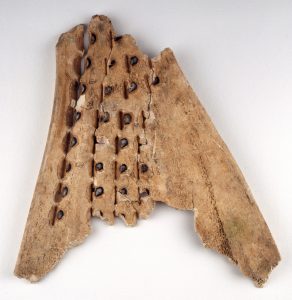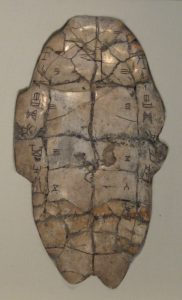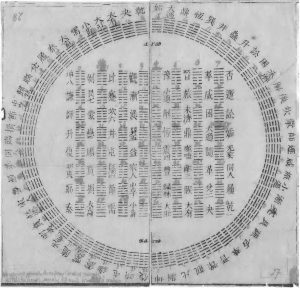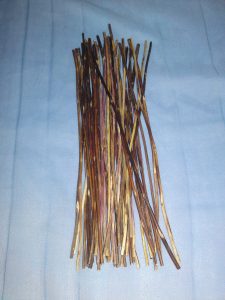3 Divination in Early China
Inaya Alkhatib
Key terms
- Oracle bones
- Divination
- Yijing (Book of Changes)
- Confucianism
- Hexagram
- Five Confucian Classics
Divination is among the earliest known human spiritual practices due to humans natural desire to know the future, understand the present, and analyze the past. It has been defined broadly as a method for obtaining knowledge not easily obtainable by normal means, including gaining information on the past and future along with contacting ancestors and spirits.[1] In early cultures this allowed kings to maintain power due to their divinatory activities granting credibility to their decisions based on the consultation of oracles. “Divining, by Yijing or other means, was a way of choosing actions that would be in accord with the Dao or ‘will of heaven.’”[2] Each culture has its own ways of utilizing divination but this chapter will be going over the Chinese methods including oracle bones and the Yijing, along with its process.

Early evidence of Chinese divination is oracle bones, which are tortoise shells that either poked with hot sticks repeatedly or heated over a flame until they cracked, with the emerging patterns (presumably trigrams) being read.[3] Originally in the Shang period, divinations were used primarily as a system for conversing with or influencing the actions of dead ancestors. In some cases, divination results on state affairs or created for the royal or elite were recorded on imperishable materials, which now serve as “indispensable parts of historical records”.[4] The process of divination with oracle bones was elaborate and expensive. With overall literacy increased, divinations on matters of personal life began to be written on bamboo or silk over oracle bones. This allowed for wider practice and thus divinations became a factor in increasing social mobility.[5] As time passed it later evolved into a system for deciphering cosmic processes and interpreting their correlations for the human world, individual people, and particular events.

To most modern people, The Yijing (also known as The Book of Changes) is known simply as a manual for finding out one’s personal divinations but it is one of the most important books in world literature. In China and East Asia, it is one of the most consulted books due to is seemingly infinite interpretations and applications making it easy for one to find evidence in it to support their own projected interpretations. Thus leading to the widespread belief in its ability to explain everything. While the origin of the book is not completely known, its contents date all the way back to the Zhou dynasty presumably sometime around 800 BCE and have served several purposes. This includes being an overall guide on how to properly live an ethical life, a manual intended to help rulers have a successful reign, and an oracle of one’s personal future along with an oracle describing the future of the ruling state. It was the building foundation for ancient Chinese cartography, medicine, sciences, etc, and it generated endless Confucian, Taoist, Buddhist, and even Christian commentaries on the meaning of the 64 hexagrams. It is one of the Five Classics, which are five pre-Qin Chinese books that form part of the traditional Confucian canon. During the Western Han dynasty, which adopted Confucianism as its official ideology, these texts became part of the state-sponsored curriculum. It was during this period that the texts first began to be considered together as a set collection, and to be called collectively the “Five Classics”.[6]

The Yijing consist of 64 different hexagrams. Hexagram in this context is a figure composed of six stacked horizontal lines, where each line is either Yang (an unbroken, or solid line), or Yin (broken, an open line with a gap in the center). The hexagram lines are traditionally counted from the bottom up, so the lowest line is considered line one while the top line is line six. Each hexagram is accompanied by obscure description with each line in the hexagram also being given a similar description.[7]
Traditionally, in order to consult The Yijing people would cast yarrow sticks and base their hexagrams upon what they received. This is a complicated and time-consuming process that involves constantly resorting sticks.

Video demonstrating the Yijing yarrow stalk method:
If you prefer a textual guide: Ways to Consult I-Ching (Yarrow Method). This does the same technique as the video guide with the only difference being the reasoning behind their steps.
How you can expand this chapter
For anybody who is interested in knowing more about this aspect of Chinese History, research further into the following topics:
- the Five Confucian Classics
- Confucian aspects of the Yijing
- Five Phases (wu xing)
- yin-yang theory
Bibliography
- Nylan, Michael. The Five “confucian” Classics. New Haven: Yale University Press, 2001.
- O´Brien, Paul. Divination Sacred Tools for Reading the Mind of God. U.S. Games Systems, 2014.
- Redmond, Geoffrey P, and Tze-Ki Hon. Teaching the I Ching (book of Changes). Aar Teaching Religious Studies. Oxford: Oxford University Press, 2014.
- Wilhelm, Richard, and Cary F Baynes. The I Ching : Or, Book of Changes. [3d Ed.] ed. Bollingen Series, 19. Princeton, N.J.: Princeton University Press, 1985.
- Geoffery Redmond and Tze-Ki Hon, Teaching the I Ching (Book of Changes), (New York, Oxford University Press, 2014), ch.1 abstract ↵
- Ibid. ↵
- Paul O´Brien, Divination Sacred Tools for Reading the Mind of God. (U.S. Games Systems, 2014), Excerpt. ↵
- Redmond, Hon, Teaching the I Ching, 20. ↵
- Ibid., 20-21. ↵
- Michael Nylan, The Five “Confucian” Classics, (New Haven & London, Yale University Press, 2001), 1-3. ↵
- Richard Wilhelm, Cary F. Baynes, The I Ching or Book of Changes, (Princeton, Princeton University Press, 1967) ↵
